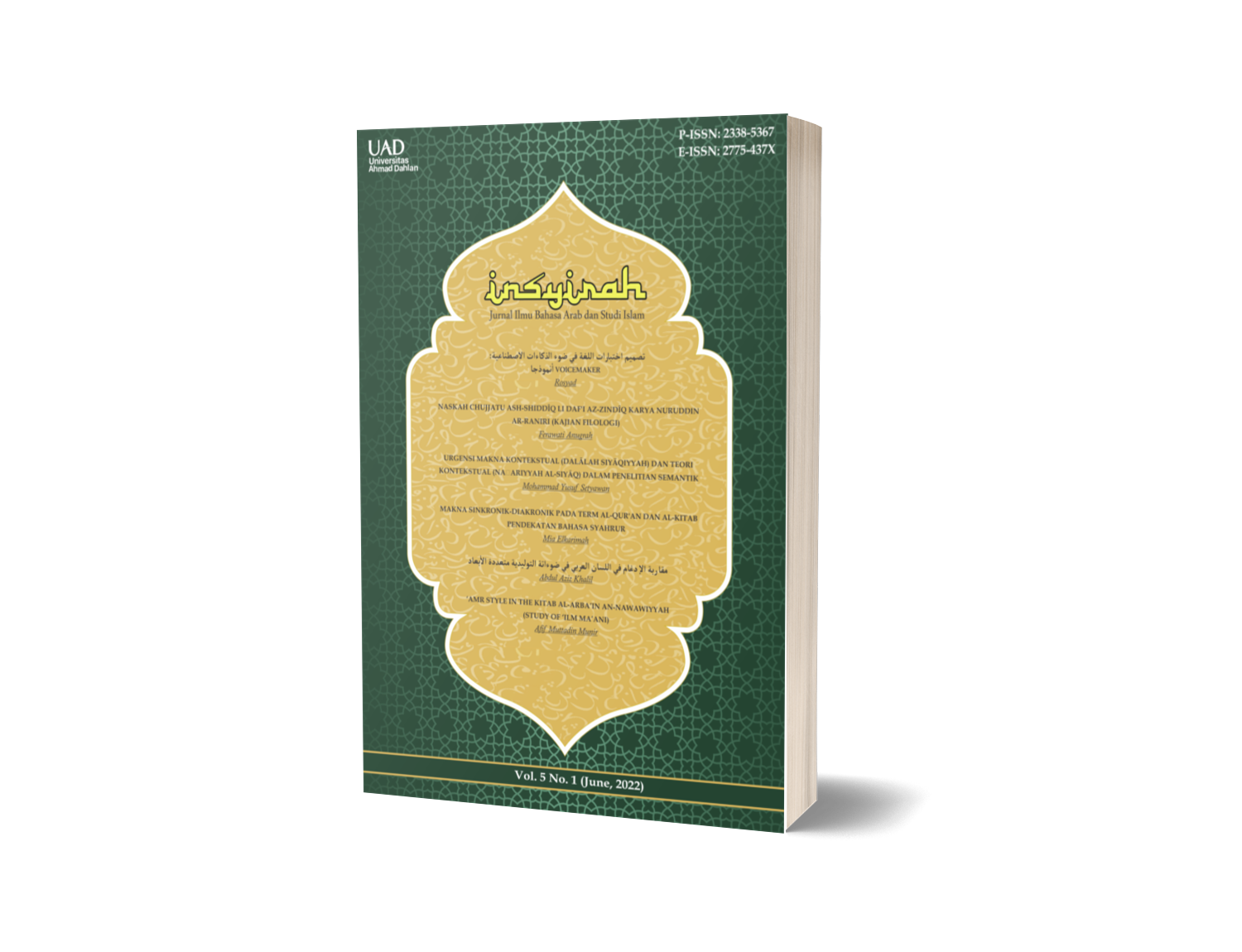Pause (Mafsāl) Analysis Using Audio Praat Application in Shaikh Dr. Malik Husain Sya'ban's Lecture
DOI:
https://doi.org/10.26555/insyirah.v5i2.6133Keywords:
Pause (mafsal), Praat Audio, LecturesAbstract
Language is one of the important aspects of the key to understanding the specific goals and purposes used by people around the world, language as a tool serves as a significant communication tool developing in human civilization. this is evidenced by many types of supporting applications, the Praat program which can change sound waves that previously could only be heard now become visible to the human eye. In addition, the Praat program, is equipped with a device to see the tone motion, the magnitude of the pause, the length of the utterance, all of which are needed to determine the inaccuracy of an utterance or the error of the utterance. This study discusses the analysis of the lectures of Shaykh Dr. Malik Husain Sya'ban based on the theory of mafsal pause in Ulumu al-lughohwiyah. The purpose and objective of this study is to determine the intonation of the pauses of these expressions. To answer these problems, in this study using qualitative descriptive analysis techniques in analyzing the results of observations made, then transcribed and then analyzed and data taken from the observations of researchers in the lectures of Shaykh Dr. Malik Husain Sya'ban.
References
Abdul Chaer. (2557). Linguistik Umum. 4(1), 88–100.
Ceramah Singkat Syaikh Dr. Malik HUsain Sya’ban. (n.d.). Yufid Tv. https://www.youtube.com/watch?v=mPPWGAtOiVQ
Chaer, A. (2007). Linguistik Umum. Rineka Cipta.
Gorjian, B., Hayati, A., & Pourkhoni, P. (2013). Using Praat Software in Teaching Prosodic Features to EFL Learners. Procedia - Social and Behavioral Sciences, 84(2005), 34–40. https://doi.org/10.1016/j.sbspro.2013.06.505
Heryono, H. (2019). Pengukuran Pitch dan Intensity Diftong Tertinggi Menggunakan Program PRAAT. Jurnal Linguistik Komputasional (JLK), 2(2), 47. https://doi.org/10.26418/jlk.v2i2.22
Isam, H., & Awal, N. M. (2012). Nilai setia dari perspektif prosodi semantik: Analisis berbantu data korpus. GEMA Online Journal of Language Studies, 12(2), 359–374.
Kamus Besar Bahasa Indonesia. (2011).
Krasono, O. M. F. (2015). Pemanfaatan Teknologi Media Program Praat Dalam Pendidikan Bahasa. Scientific Repository, 151, 10–17.
Lafamane, F. (2020). FONOLOGI (Sejarah Fonologi, Fonetik, Fonemik). Jurnal Bahasa, 2, 25.
Luhur Wicaksono. (2016). Bahasa Dalam Komunikasi Pembelajaran Luhur Wicaksono. J P P Journal of Prospective Learning, 1(2), 9–19. http://jurnal.untan.ac.id/index.php/lp3m
Magdin, M., Sulka, T., Tomanová, J., & Vozár, M. (2019). Voice Analysis Using PRAAT Software and Classification of User Emotional State. International Journal of Interactive Multimedia and Artificial Intelligence, 5(6), 33. https://doi.org/10.9781/ijimai.2019.03.004
Marlina, L. (2019). Pengantar Ilmu Ashwat. In Fajar Media Bandung (Vol. 1, pp. 1–235). http://digilib.uinsgd.ac.id/30539/1/PENGANTAR ILMU ASHWAT.pdf
Masnur Muslich. (2012). Fonologi Bahasa Indonesia: Tinjauan Deskripsi sistem bunyi Bahasa Indonnesia. Bumi Aksara.
Medan, B. B. (2008). ILADANG Tengku Syarfina.
Melayu, B., & Reconstru, P. (2022). Rekonstruksi Fonologi Vokal Bahasa Jakun : Suatu Analisis Fonologi Diakronik Dengan Bahasa Melayu. October. https://doi.org/10.37052/jb22(2)no1
Muslich, M. (2008). Fonologi bahasa Indonesia: Tinjauan deskriptif sistem bunyi bahasa Indonesia. Bumi Aksara.
Negara, A. B. P., Muhardi, H., & Muniyati, E. F. (2020). Prediksi Jeda dalam Ucapan Kalimat Bahasa Melayu Pontianak Menggunakan Hidden Markov Model Berbasis Part of Speech. Jurnal Teknologi Informasi Dan Ilmu Komputer, 7(4), 755. https://doi.org/10.25126/jtiik.2020742166
Noor-Book.com مدخل إلى نظرية المعرفة 2 .pdf. (n.d.).
Owren, M. J. (2008). GSU Praat tools: Scripts for modifying and analyzing sounds using Praat acoustics software. Behavior Research Methods, 40(3), 822–829. https://doi.org/10.3758/BRM.40.3.822
Pelajaran, M., Keahlian, P., Xi, B. A. B., & Xi, B. A. B. (2016). Bab xi.
Retno Ningsih, T. W. (2020). Analisis Prosodi pada Monolog Aktor Film Menggunakan Aplikasi Praat (Kajian dalam Bidang Fonetik Akustik). Nusa: Jurnal Ilmu Bahasa Dan Sastra, 15(4), 419–432. https://doi.org/10.14710/nusa.15.4.419-432
Sugiyono. (2003). Pemarkah Prosodik Kontras Deklaratif dan Interogatif Bahasa Melayu Kutai. Universitas Indonesia.
Suparyanto dan Rosad (2015. (2018). Aplikasi Linguistik Arab Terhadap Bacaan Waqaf Dan Ibtida’ Dalam Al-Qur’an. Nurul Huda Binte Mohd Hashim, 5(3), 248–253.
Suryani, Y., & Darmayanti, N. (2012). Kemahiran Berbahasa Indonesia Penutur Korea : Kajian Prosodi Dengan Pendekatan Fonetik the Skill of Korean Speakers in Indonesian Language : Prosody Study Using an Experimental Phonetics Approach. Sigma-Mu, 4(2), 52–63.
Susiati, S. (2020). Kaidah-Kaidah Fonologi. May. https://doi.org/10.13140/RG.2.2.34698.08648
Utomo, R. B. (2015). Perbedaan Pola Spektrum Frekuensi Suara Pengucapan Daftar Tutur Kata Bahasa Indonesia pada Anak dengan Geligi Protrusif (Kajian pada Anak Laki-Laki Umur 9 dan 12 Tahun). Majalah Kedokteran Gigi Indonesia, 20(2), 176. https://doi.org/10.22146/majkedgiind.9225
Widagdo, T. B., & Yustanto, H. (2019). Karakteristik Prosodi Werkudara dalam Wayang Purwa (Kajian Fonetik Akustik). Prosiding Seminar Nasional Linguistiks Dan Sastra (SEMANTIKS), 690–696.
Wiratno, T., & Santosa, R. (2014). Bahasa, Fungsi Bahasa, dan Konteks Sosial. Modul Pengantar Linguistik Umum, 1–19. http://www.pustaka.ut.ac.id/lib/wp-content/uploads/pdfmk/BING4214-M1.pdf
Wirdati, Rivauzi, A., Sulaiman, Anwar, F., & Kosasih, A. (2020). The Student’s Ability to Read the Qur’an at Islamic Education Program Universitas Negeri Padang (A Need Assessment Study). 125(Icpapg 2019), 370–376. https://doi.org/10.2991/aebmr.k.200305.221
Yakop Colin and Clark, J. (1991). Introduction to Phonetics and Phonemics. Basil Black Well, Ltd.
Yuliati, R., & Unsiah, F. (n.d.). Fonologi (T. U. Press (Ed.); First). Ub press malang.
Downloads
Published
Issue
Section
License
Copyright (c) 2022 Semaun Al Usman, Thonthowi, Tulus Musthofa

This work is licensed under a Creative Commons Attribution-ShareAlike 4.0 International License.








